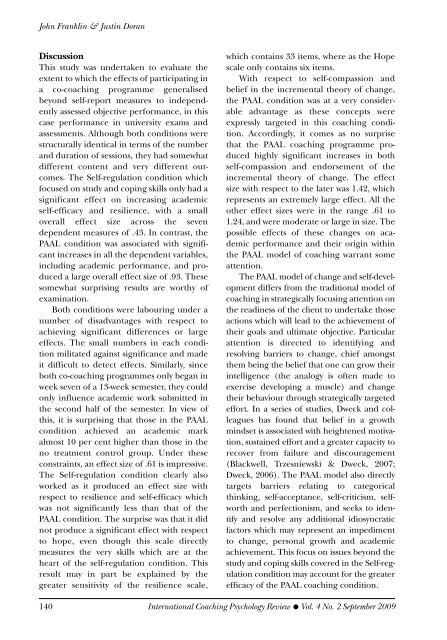International Coaching Psychology Review, 4.2, September 2009
International Coaching Psychology Review, 4.2, September 2009
International Coaching Psychology Review, 4.2, September 2009
Create successful ePaper yourself
Turn your PDF publications into a flip-book with our unique Google optimized e-Paper software.
John Franklin & Justin Doran<br />
Discussion<br />
This study was undertaken to evaluate the<br />
extent to which the effects of participating in<br />
a co-coaching programme generalised<br />
beyond self-report measures to independently<br />
assessed objective performance, in this<br />
case performance in university exams and<br />
assessments. Although both conditions were<br />
structurally identical in terms of the number<br />
and duration of sessions, they had somewhat<br />
different content and very different outcomes.<br />
The Self-regulation condition which<br />
focused on study and coping skills only had a<br />
significant effect on increasing academic<br />
self-efficacy and resilience, with a small<br />
overall effect size across the seven<br />
dependent measures of .43. In contrast, the<br />
PAAL condition was associated with significant<br />
increases in all the dependent variables,<br />
including academic performance, and produced<br />
a large overall effect size of .93. These<br />
somewhat surprising results are worthy of<br />
examination.<br />
Both conditions were labouring under a<br />
number of disadvantages with respect to<br />
achieving significant differences or large<br />
effects. The small numbers in each condition<br />
militated against significance and made<br />
it difficult to detect effects. Similarly, since<br />
both co-coaching programmes only began in<br />
week seven of a 13-week semester, they could<br />
only influence academic work submitted in<br />
the second half of the semester. In view of<br />
this, it is surprising that those in the PAAL<br />
condition achieved an academic mark<br />
almost 10 per cent higher than those in the<br />
no treatment control group. Under these<br />
constraints, an effect size of .61 is impressive.<br />
The Self-regulation condition clearly also<br />
worked as it produced an effect size with<br />
respect to resilience and self-efficacy which<br />
was not significantly less than that of the<br />
PAAL condition. The surprise was that it did<br />
not produce a significant effect with respect<br />
to hope, even though this scale directly<br />
measures the very skills which are at the<br />
heart of the self-regulation condition. This<br />
result may in part be explained by the<br />
greater sensitivity of the resilience scale,<br />
which contains 33 items, where as the Hope<br />
scale only contains six items.<br />
With respect to self-compassion and<br />
belief in the incremental theory of change,<br />
the PAAL condition was at a very considerable<br />
advantage as these concepts were<br />
expressly targeted in this coaching condition.<br />
Accordingly, it comes as no surprise<br />
that the PAAL coaching programme produced<br />
highly significant increases in both<br />
self-compassion and endorsement of the<br />
incremental theory of change. The effect<br />
size with respect to the later was 1.42, which<br />
represents an extremely large effect. All the<br />
other effect sizes were in the range .61 to<br />
1.24, and were moderate or large in size. The<br />
possible effects of these changes on academic<br />
performance and their origin within<br />
the PAAL model of coaching warrant some<br />
attention.<br />
The PAAL model of change and self-development<br />
differs from the traditional model of<br />
coaching in strategically focusing attention on<br />
the readiness of the client to undertake those<br />
actions which will lead to the achievement of<br />
their goals and ultimate objective. Particular<br />
attention is directed to identifying and<br />
resolving barriers to change, chief amongst<br />
them being the belief that one can grow their<br />
intelligence (the analogy is often made to<br />
exercise developing a muscle) and change<br />
their behaviour through strategically targeted<br />
effort. In a series of studies, Dweck and colleagues<br />
has found that belief in a growth<br />
mindset is associated with heightened motivation,<br />
sustained effort and a greater capacity to<br />
recover from failure and discouragement<br />
(Blackwell, Trzesniewski & Dweck, 2007;<br />
Dweck, 2006). The PAAL model also directly<br />
targets barriers relating to categorical<br />
thinking, self-acceptance, self-criticism, selfworth<br />
and perfectionism, and seeks to identify<br />
and resolve any additional idiosyncratic<br />
factors which may represent an impediment<br />
to change, personal growth and academic<br />
achievement. This focus on issues beyond the<br />
study and coping skills covered in the Self-regulation<br />
condition may account for the greater<br />
efficacy of the PAAL coaching condition.<br />
140 <strong>International</strong> <strong>Coaching</strong> <strong>Psychology</strong> <strong>Review</strong> ● Vol. 4 No. 2 <strong>September</strong> <strong>2009</strong>

















